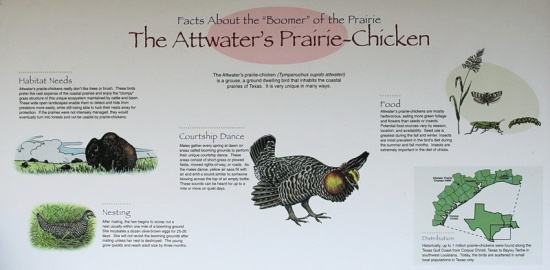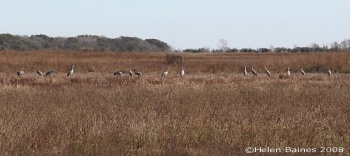
Information about the endangered Attwater's Prairie Chicken.
Click on image to see larger version
Overview
This Texas refuge, 10,528 acres in size, was established in 1972, to preserve the critically endangered Attwater's subspecies of the Greater Prairie Chicken and the coastal prairie habitat that it needs to survive. More than 250 species of birds have been seen here. The Attwater's Prairie Chicken Festival is held the second weekend of April every year (unless that is Easter, then it will be the first weekend).
- The Annual Festival is held the second weekend in April. Events include: early morning tours to the booming grounds and bird walks. See the FWS website below for details.
This refuge is part of the Great Texas Coastal Birding Trail - site no. CTC 004.
Birds
Notable Species
The last few wild Attwater's Prairie Chickens (a subspecies of the Greater Prairie Chicken) are located in a part of the refuge which is not open to the general public, in order to protect them. There are less than 100 birds at three protected sites - the Attwater Prairie Chicken National Wildlife Refuge, the Texas City Prairie Preserve and private land near Goliad, Texas. There are captive breeding programs at the Houston Zoo, San Antonio Zoo and the Fossil Rim Wildlife Center, Glen Rose.
Other notable species found here are: White-tailed Hawk, Crested Caracara, Sprague's Pipit, Dickcissel, rails, sparrows and wintering ducks and geese, when the marshes are full of water.
Rarities
Least Grebe, Masked Duck, Zone-tailed Hawk, Golden Eagle, Prairie Falcon, Say's Phoebe.
Check-list
Birds you can see here include:
Black-bellied Whistling Duck, Fulvous Whistling Duck, Greater White-fronted Goose, Snow Goose, Ross's Goose, Canada Goose, Gadwall, American Wigeon, Mallard, Mottled Duck, Blue-winged Teal, Cinnamon Teal, Northern Shoveler, Northern Pintail, Green-winged Teal, Canvasback, Redhead, Ring-necked Duck, Greater Scaup, Lesser Scaup, Bufflehead, Ruddy Duck, Northern Bobwhite, Greater Prairie Chicken, Pied-billed Grebe, Eared Grebe, Wood Stork, Neotropic Cormorant, Double-crested Cormorant, Anhinga, American White Pelican, American Bittern, Least Bittern, Great Blue Heron, Great Egret, Snowy Egret, Little Blue Heron, Tricolored Heron, Reddish Egret, Cattle Egret, Green Heron, Black-crowned Night Heron, Yellow-crowned Night Heron, White Ibis, Glossy Ibis, White-faced Ibis, Roseate Spoonbill, Black Vulture, Turkey Vulture, Osprey, White-tailed Kite, Northern Harrier, Sharp-shinned Hawk, Cooper's Hawk, Bald Eagle, White-tailed Hawk, Red-shouldered Hawk, Swainson's Hawk, Red-tailed Hawk, Yellow Rail, Black Rail, Clapper Rail, King Rail, Sora, Purple Gallinule, Common Gallinule, American Coot, Sandhill Crane, American Golden Plover, Killdeer, Black-necked Stilt, American Avocet, Spotted Sandpiper, Solitary Sandpiper, Greater Yellowlegs, Lesser Yellowlegs, Upland Sandpiper, Long-billed Curlew, Semipalmated Sandpiper, Western Sandpiper, Least Sandpiper, Pectoral Sandpiper, Dunlin, Stilt Sandpiper, Short-billed Dowitcher, Long-billed Dowitcher, Wilson's Snipe, Ring-billed Gull, Rock Dove, Eurasian Collared Dove, White-winged Dove, Mourning Dove, Inca Dove, Common Ground Dove, Yellow-billed Cuckoo, Greater Roadrunner, Barn Owl, Great Horned Owl, Short-eared Owl, Common Nighthawk, Chimney Swift, Ruby-throated Hummingbird, Belted Kingfisher, Red-bellied Woodpecker, Yellow-bellied Sapsucker, Downy Woodpecker, Northern Flicker, Crested Caracara, American Kestrel, Merlin, Peregrine Falcon, Eastern Phoebe, Eastern Kingbird, Scissor-tailed Flycatcher, Loggerhead Shrike, White-eyed Vireo, Blue-headed Vireo, Blue Jay, American Crow, Northern Rough-winged Swallow, Purple Martin, Tree Swallow, Barn Swallow, Cliff Swallow, Cave Swallow, Carolina Chickadee, Tufted Titmouse, House Wren, Winter Wren, Sedge Wren, Marsh Wren, Bewick's Wren, Carolina Wren, Blue-gray Gnatcatcher, Golden-crowned Kinglet, Ruby-crowned Kinglet, Eastern Bluebird, Hermit Thrush, American Robin, Gray Catbird, Northern Mockingbird, Brown Thrasher, European Starling, American Pipit, Sprague's Pipit, Cedar Waxwing, Orange-crowned Warbler, Common Yellowthroat, Yellow-rumped Warbler, Wilson's Warbler, Chipping Sparrow, Clay-colored Sparrow, Field Sparrow, Vesper Sparrow, Lark Sparrow, Savannah Sparrow, Grasshopper Sparrow, Le Conte's Sparrow, Fox Sparrow, Song Sparrow, Lincoln's Sparrow, Swamp Sparrow, White-throated Sparrow, Harris's Sparrow, White-crowned Sparrow, Northern Cardinal, Dickcissel, Red-winged Blackbird, Eastern Meadowlark, Western Meadowlark, Brewer's Blackbird, Common Grackle, Great-tailed Grackle, Brown-headed Cowbird, Orchard Oriole, Baltimore Oriole, American Goldfinch, House Sparrow
Other Wildlife
The refuge has about 50 species of mammals, most of which are nocturnal. Bobcats, coyotes and the nine-banded armadillos roam the refuge at night, while during the day you will see the re-introduced bison, plus 13-lined ground squirrel and black-tailed jackrabbit, if you are lucky. The refuge is also home to the American alligator, plus spiny softshell turtles, bullfrogs and upland chorus frogs. Don't forget there are venomous snakes there, too - Texas coral, western cottonmouth and southern copperhead snake. Butterflies and dragonflies are abundant in the Spring and Summer months.
Site Information
History and Use
The refuge was established in 1972, to protect, restore and maintain the native coastal prairie which is essential habitat for the Attwater's Prairie-Chickens.
Areas of Interest
- 2 hiking trails: Pipit Trail (1.5 miles) and the Sycamore Trail (2 miles).
- Auto tour loop (5 miles) with views of the prairie, Teal Marsh and Pintail Marsh.
Access and Facilities
- Entrance is free of charge
- A 2 hour guided van tour of the refuge is available on the first Saturday of every month. Reservations are required - contact the refuge at the email or phone number below.
- Open dawn to dusk, daily.
- Visitor Center: Monday - Friday, 7:30am to 4pm. Closed weekends.
- Toilets at the Visitor Center open every day
- Entrance is free of charge
Directions
The refuge is located 6.5 miles northeast of Eagle Lake, off FM 3013. If traveling from Houston, take I10 west, then south from Sealy on Highway 36, and turn right onto FM 3013, and look for the Refuge entrance on the right. The HQ and Visitor Center are located 2 miles west of the main entrance on FM 3013.

Sandhill Cranes wintering on the prairie, Dec. 2008. Click on image to see a larger version
Contact Details
Attwater Prairie Chicken NWR
PO Box 519
Eagle Lake, TX 77434
Phone: 979-234-3021
Email: [email protected]
Content and images posted by HelenB







